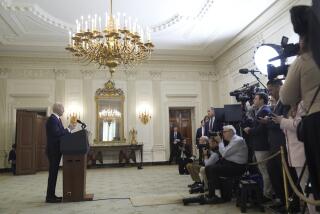Cost-cutting is the scourge of television news
Chances are youâve never heard of Larry Doyle. I had no idea who he was until last week, when the news division at CBS let him go after 40 years.
Yes, CBS had another round of firings, and the loss of Doyle, the networkâs top war news producer, showed how deep these cuts really were. Dan Rather told the New York Observer that Doyle was âthe soul of the place.â
Everyone was told this purge was a response to the devastating ad market of 2009. TV news layoffs are often spun as cyclic when, in fact, they are secular, part of the retrenching of a still-powerful but no longer influential media sector. Katie Couric can still get a lot of mileage from a gotcha, but thereâs no sense waiting for the next âHarvest of Shameâ to come along. (Shame went out of style long ago at the networks.)
So what happens when thereâs a big, boring but hugely important story that affects 100 million Americans -- say, airline safety? Well, we saw what happened last week, when the nightly newscasts all reported on the governmentâs report into the Continental 3407 crash in Buffalo, which killed 50 people one year ago.
As CBS reporter Nancy Cordes told Couricâs viewers last week, the report blamed the tragedy on âa series of easily avoidable mistakesâ by the airplaneâs captain and first officer. Concerns also were raised about the company that put them in the cockpit, Colgan Air, a low-cost puddle jumper that partners with Continental and other major carriers.
Cordes even mentioned that the problem might be systemic, requiring the FAA to draft new regulations for regional airlines, which have been involved in every domestic plane fatality since 2002. But a two-minute news report is not a very large or sturdy container, and frankly, after Cordes had finished blaming the pilots, everything else was blah-blah-blah.
The Colgan Air report faded next to the relentless coverage of the Toyota recall, an important story, to be sure, but one affecting a fraction of the number of people who take commuter flights. Both stories involve federal regulators, but a product recall means a hazard could be sitting in your driveway! Thatâs an easy sell. This recall also came fully loaded with an us-versus-them sidebar.
âAs Toyota sales were falling last month, Fordâs were up 24%,â Couric chirped last week.
Hereâs the paradox of big, boring stories such as airline safety. If you throw enough resources at one of them, youâll flesh out the details needed to turn it into a fairly spellbinding narrative. But if you do that, you wonât make money. If youâre smart with it, though, you might build your audience. Newspapers know this. CBS used to know this.
As it happens, the PBS news magazine âFrontlineâ chose the one-year anniversary of the Buffalo crash to air its investigation, âFlying Cheap.â The report, which aired Tuesday night, rewinds to the dawning of the deregulatory era 30 years ago, then walks us back to the present day, methodically showing how the commuter business grew to 52% of all airline travel and how two inexperienced pilots were allowed in that cockpit.
As someone who has studied the history of government oversight of media, I found âFrontlineâsâ story all-too-familiar. It outlined a case of overburdened regulators asking the industry to keep tabs on itself. The industry responded by building what one of âFrontlineâsâ talking heads called a âfirewallâ between the major carriers and their regional partners.
A former Colgan pilot told âFrontlineâ he got promoted to captain with 500 hours of flight time, less than a third of what the majors require. Pilots are paid only when the cabin door closes, so they work 16-hour days for perhaps $21,000 a year. Thereâs no pay for canceled flights, so they take chances with stormy weather.
And when a plane goes down? Incredibly, the major airline that âincentivizesâ (not my word) this risky behavior is shielded from liability. And the government? As Mary Schiavo, the FAAâs inspector general during the Clinton/ValuJet years, puts it: âThe FAA protects airlines.â
âFrontlineâsâ correspondent was Miles OâBrien, who was one of my favorite CNN anchors until he and the networkâs entire science team were fired in 2008. Between the PBS exposure and likely tie-ins with NPR, OâBrienâs reporting will probably be seen and heard by more Americans than saw him on cable. PBS also has put the report online in perpetuity.
Will other networks follow? During a decade when the cost of gathering news plummeted, meaning that networks could do more with less, they have instead done less with less. Ken Auletta of the New Yorker recently documented how correspondents such as NBCâs Chuck Todd have become victims of the Internet news cycle. They are on camera all day, while enterprise suffers.
A nonprofit venture such as âFrontlineâ isnât immune to this trend. In 2009, it produced 16 films that ate up 17 hours of PBS prime time. Ten years earlier, âFrontlineâ produced 17 films with 22 hours of in-depth reporting. Five fewer hours, and one less assignment, no doubt saved PBS stations a pile of pledge dollars.
Everywhere you look, TV news is saving money. And as Miles OâBrien, Larry Doyle and thousands of other journalists might say in response: At what cost?
Aaron Barnhart writes for the Kansas City Star.
More to Read
The biggest entertainment stories
Get our big stories about Hollywood, film, television, music, arts, culture and more right in your inbox as soon as they publish.
You may occasionally receive promotional content from the Los Angeles Times.










